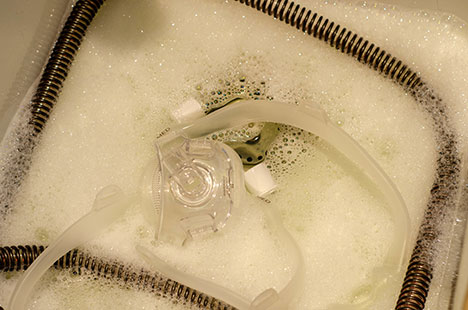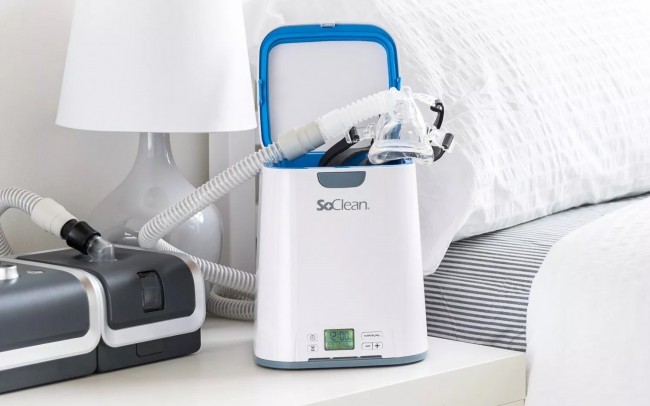Last updated on July 6th, 2023 at 03:31 pm

This recent global pandemic has placed everyone on edge. As the number of infected continues to rise throughout the United Kingdom, we are left wondering when the peak will finally arrive as well as how many individuals will eventually succumb to this illness.
While this is no doubt a concern for the average person, we need to keep in mind that such a relatively high mortality rate is partially caused by the fact that COVID-19 dramatically impacts the respiratory tract. Thus, anyone who is currently coping with obstructive sleep apnoea is at an even higher risk of developing serious complications.
Of course, issues such as social distancing and the proper hygiene come into play. This is why cleanliness is a subject which cannot be taken for granted during these trying times.
We are referring to the proper maintenance of your CPAP machine in this respect.
What dangers are associated with an improperly cleaned unit? How might these increase your chances of developing a serious respiratory tract infection? And what steps can you take in order to ensure that nothing is left to chance?
If you have been worried about the effects of coronavirus, the information below is vitally important to consider.
Common Hazards Associated with Improperly Cleaned Equipment
One of the issues with a continuous positive airway pressure machine is that the apparatus will come into direct contact with your face, nose and mouth. This is particularly dangerous if it has not been maintained properly, as a number of hazards can be present. The most common include:
- Mould
- Bacteria
- Airborne particulate matter
- A buildup of minerals within the internal components
The presence of these and other substances can likewise lead to allergies, more severe symptoms of underlying conditions such as asthma and naturally, difficulty remaining asleep during the overnight hours. However, we have not yet factored in the recent coronavirus outbreak.
The Link with Coronavirus
The majority of severe reactions and death as the result of coronavirus are due to the fact that this illness enters into the respiratory tract and eventually, begins to infect the lungs. As the body becomes deprived of oxygen, the organs find it more difficult to perform their vital functions. Even with targeted treatment methods (such as the use of a ventilator), some individuals will eventually succumb.
This situation is of critical importance, as those who have been diagnosed with OSA may already be suffering from breathing problems.
Assuming that they are diagnosed with COVID-19, the chances are high that the associated symptoms will be much worse. After all, we need to keep in mind that you are essentially breathing in air that is being recirculated within the machine itself.
Any germs or contaminants that may be present are therefore extremely likely to enter into the lungs.
It does not take a trained medical technician to appreciate the risks in such situations. This is even more important when referring to those who already have a compromised immune system or other conditions such as diabetes or obesity.
How Frequently Should a Cleaning Take Place?
Now that we have begun to appreciate why it is crucial to keep your machine in top working order, the next question involves how often it should be proactively maintained.
We need to keep in mind that the majority of individuals employ this unit on a nightly basis in order to obtain the adequate amount of sleep. Therefore, it will endure a significant amount of wear and tear (as well as exposure to airborne as well as biological agents).
The main question now involves what type of schedule you should adopt.
You can begin by reading the instructions provided by the device’s manufacturer. There will be a section devoted to maintenance and the official guidelines are found here.
However, it could also be a good idea to speak with your physician or personal sleep specialist. He or she may recommend that critical components such as the water chamber, hose and mask be cleaned every day. While this might seem slightly laborious, we need to remember that it is better to be safe than sorry in this day and age.
At the bare minimum, the majority of experts recommend that the machine should be cleaned once every week. If you happen to be suffering from a respiratory illness or should someone in your house have recently fallen ill, it is prudent to immediately clean the main accessories. This will help to present the spread of germs and hopefully, to avoid more serious consequences.
Your Step-By-Step Cleaning Guide
You will be pleased to know that the cleaning process itself is rather straightforward and you do not require complicated equipment. Here is a list of some essential items which should be procured in advance:
- A soft cloth (such as a terry cloth)
- A bowl of tepid water
- Antibacterial soap or common dish soap
- A dry towel
After you have obtained these accessories, you will need to perform five simple steps.
First, disassemble the machine and its constituent parts. Be sure to unplug the unit in order to avoid an accidental shock. Detach the mask, the tubing, the water chamber, and any similar connectors that might be unique to your model. You will then wipe down the entire surface of the machine. This is mainly to remove any debris or dust that may be present.
Then, submerge the components (the mask, the hose, the tubing, and any connectors) into a bowl of warm water and soap. You might also choose to add an equal amount of white vinegar into the mixture. While this is optional, it can help to remove any minerals that may be present as the result of hard water.
Allow all of these components to soak for approximately 30 minutes. While they can be wiped down with a dry towel after they are cleaned, it is best to let them naturally air dry.
Another suggestion is examine the filter (if your machine is equipped with one). There are times when a filter can be cleaned as per manufacturer guidelines while other models might require a new replacement. If applicable, be sure to address this concern.
Once all of the components have been cleaned and dried, you can reassemble the parts into their correct places. Be sure to refer to the owner’s manual if you have any doubts about where each belongs.
After they are all in place, activate the machine and listen for any air leaks or other sounds that were not previously present. These could indicate a poor seal. If you feel that the unit is not functioning properly, it is always wise to consult with a trained professional or the manufacturer.
An Ounce of Prevention
A CPAP machine represents one of the most effective ways to treat the symptoms associated with obstructive sleep apnoea. However, safety is always important. The fact of the matter is that this recent viral pandemic has taken the medical community by surprise. This is why nothing should be left to chance in regards to your health and hygiene.
Proactively cleaning your machine is one of the best ways to prevent infection and let’s also remember that a well-maintained unit will rarely ay problems in terms of functionality. Always speak with your sleep specialist for additional advice or if you have any questions.
To shop for the highest-quality selection of CPAP devices (and Oral Devices) click here


